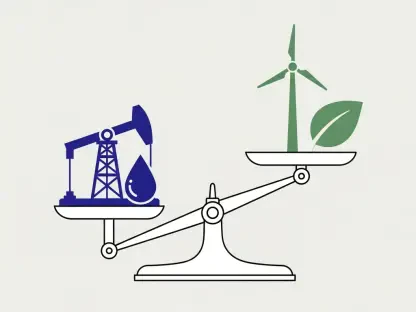Setting the Stage for a Green Revolution
The European Union has embarked on a transformative journey, targeting a staggering 90% reduction in net planet-warming emissions by 2040, a goal recently endorsed by a key parliamentary committee. This ambitious plan is not just a policy statement but a seismic shift that could redefine industries, trade dynamics, and investment landscapes across the continent and beyond. With global climate pressures mounting, the EU’s commitment positions it as a frontrunner in environmental stewardship, yet it also raises critical questions about economic feasibility and market competitiveness. This analysis explores the implications of this target for various sectors, dissecting the trends, challenges, and opportunities it presents in a rapidly evolving global market.
Decoding Market Trends and Projections
Policy as a Catalyst for Green Investment
The EU Parliament’s environment committee voted decisively in favor of the 2040 emissions target, with 49 supporting, 33 opposing, and 6 abstaining, signaling strong political momentum despite dissent. This policy is poised to act as a powerful driver for green investments, particularly in renewable energy sectors like wind, solar, and green hydrogen. Market forecasts suggest that capital inflows into clean technology could surge by over 30% in the next five years if regulatory frameworks tighten as planned. However, the allowance of up to 5% of reductions via foreign carbon credits—lowering domestic cuts to 85%—introduces a layer of complexity, potentially slowing the pace of local innovation as firms might opt for cheaper offsets abroad.
Industrial Challenges and Competitive Risks
European industries, already grappling with rising operational costs and external pressures such as potential U.S. tariffs, face a delicate balancing act under this climate target. Sectors like manufacturing and heavy industry, which contribute significantly to emissions, may encounter increased compliance costs, risking competitive disadvantages compared to regions with less stringent regulations, such as parts of Asia or North America. Analysts predict that without substantial government subsidies or technological breakthroughs, profit margins in these sectors could shrink by 10-15% over the next decade. The carbon credit compromise, while offering short-term relief, might delay critical transitions to sustainable practices, creating long-term vulnerabilities in market positioning.
Opportunities in Emerging Green Markets
On the flip side, the EU’s aggressive climate goal opens up vast opportunities for businesses willing to pivot toward sustainability. The demand for carbon capture technologies, energy-efficient solutions, and sustainable supply chains is expected to grow exponentially, creating new market niches. Companies in the renewable energy sector could see revenue growth of up to 20% annually as policies incentivize adoption through carbon pricing and tax breaks. Furthermore, the stricter rules on carbon credits—limiting purchases to countries aligned with the Paris Agreement—could spur cross-border partnerships, fostering a more integrated global green economy and positioning EU firms as leaders in this space.
Sectoral and Regional Market Dynamics
Divergent Impacts Across EU Member States
The 2040 target reveals significant disparities in market readiness across the EU’s 27 member states, influencing regional investment patterns. Nations with robust renewable infrastructure, such as those in Scandinavia, are likely to attract more green capital, while fossil fuel-dependent economies in Eastern Europe may struggle with transition costs, potentially seeing slower GDP growth in the near term. Market analysis indicates that regional disparities could widen economic divides, with wealthier states accelerating decarbonization while others lag, necessitating targeted EU funding to bridge the gap. This uneven impact underscores the challenge of maintaining a cohesive market response to climate policy.
Political Tensions Shaping Economic Outcomes
Political divisions within the EU also play a critical role in shaping market outcomes, as seen in the opposition from far-right groups like the Patriots for Europe, who sought to scrap the target citing consumer cost burdens. Although their proposal was rejected, such resistance highlights potential policy volatility that could deter long-term investments in green sectors. Conversely, the consensus among center-right, socialist, and green lawmakers suggests a stable foundation for policy continuity, which is crucial for market confidence. Businesses must navigate this political landscape, anticipating shifts that could either accelerate or hinder climate-driven market reforms.
Strategic Insights from a Climate-Driven Market Shift
Looking back, the EU’s commitment to slashing emissions by 90% by 2040, despite the compromise on carbon credits, marked a pivotal moment in reshaping market landscapes. The journey revealed both the transformative potential of stringent climate policies and the inherent challenges of aligning economic realities with environmental goals. For businesses, the path forward involves leveraging emerging opportunities in green technologies while mitigating risks through strategic partnerships and innovation. Policymakers need to prioritize equitable support mechanisms to address regional disparities, ensuring no market is left behind. As global attention turns to the EU’s next steps, stakeholders across industries should prepare for a future where sustainability is not just a goal but a core driver of competitive advantage.









